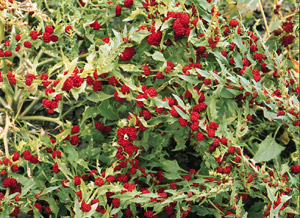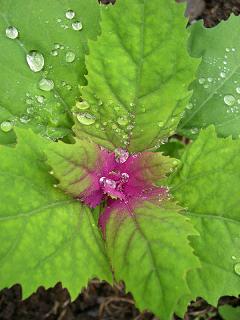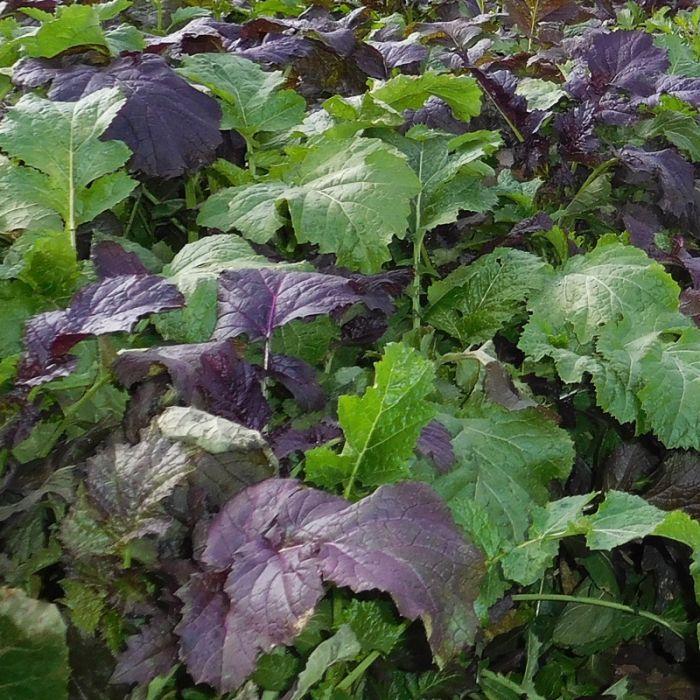Mustard and other Greens Seed
Useful gardening information
Informative articles found on the web:
How to Grow Mustard Greens
Mustard Seeds






Red Streaks has wispy, frilly, dark green leaves with burgundy streaks. Its taste is mild for a mustard. 45 days. 20 days for baby leaf.


Other Types of Greens

Good King Henry may have become something of a rarity today, but this unique herb still has much to offer to the home or cottage gardener.
A perennial herb in the family Chenopodiaceae, the same plant family as some familiar vegetables (including beetroot and chard) and some other useful but more unusual plants including quinoa and tree spinach. This unique herb possesses many unusual functions. One of its many common names is "All Good" and pretty much all of the plant can be eaten.
The succulent young leaves and flowering stems can be either eaten in salads or cooked like spinach. The seed can be ground and mixed with flour then used in making bread. Known as 'poor man's asparagus', the growing shoots can be tie together in bundles, cooked and eaten like asparagus. Considered to be a gourmet food, young flower buds can be sauteed in butter
It has been used as a herbal medicine to alleviate stomach-ache. The seed is a gentle laxative that is suitable for children. Chickens especially seem to have a special fondness for Good King Henry; one of its common names is "fat hen".
The root is used as a cough remedy for livestock such as sheep and goats.

A green that is grown and eaten like spinach before the small strawberry like fruits appear on the stems of the plant. This plant has been around for over 400 years and was a favorite of English Monks long ago. Smaller,thinner leaves than ordinary spinach, with abundance of thumbnail size fruits which are tasty.
Useful cut material, grows 15" tall, ready in 12 weeks from seed. Annual.

This is a beautiful plant to grow with it’s soft green goosefoot shaped leaves that have a splash of magenta-pink on the newest leaves of each stem. It is an annual, meaning it grows for one season, and then dies down. This plant can reach over two metres, appearing like a small tree, and as such is also known as tree spinach. It is much easier to grow than regular spinach though and more productive. Magenta spreen is also called lamb's quarters. It is sown in the spring and quickly grows during summer producing side shoots that can be picked for cooking like spinach. Just one plant can produce a huge amount of food.

Nemagon White Mustard

Nemagon white mustard seeds also contains high levels of glucosinate which is a compound similar to those found in commercial soil fumigants. It also features exceptional fast growth forming a compact covering to obstruct weeds.
The deep root system does a great job of re-utilizing nutrients that may have filtered past the root zone of crop plants. The tap root grows to a depth of three feet which helps break up soil and scavenge nutrients. Use Nemagon white mustard seed as a winter cover crop in home gardens, crop rotations and vineyards. It provides natural weed suppression, increased tilth, and increased organic soil matter. Nemagon is high in sulfer, which can become available to the subsequent crop when the mustard is incorporated in to the soil. Do not permit the mustard to go to seed or it could become a field impurity.
One pound will cover about 3,500 square feet.
Caliente 199 Mustard Blend for Biofumigation
 Every so often we come across a gardening technique that is so wonderful we have to stop and ponder "why in the world have we not been doing this in the past"?
Every so often we come across a gardening technique that is so wonderful we have to stop and ponder "why in the world have we not been doing this in the past"? This is one of those techniques, one that is used by large crop growers and is now available to gardeners with small growing areas. It is as simple as sowing a fast growing blend of mustard seeds when your gardening season is about over with, then chopping up the mustards and tilling them into the soil.
Everyone who has a garden or flower bed that is used season after season should seriously consider improving their soil by green manuring with Caliente 199 Mustards Seed Mix.
This is a natural way to import excellent disease, weed and nematode suppression in future plantings and not have to rely on chemicals and fumigants. Ideal for organic growers.
This mustard blend can be used in small beds, gardens, truck patches and crop fields.
Being a member of the mustard family, it grows vigorously in a short period of time, ready to chop and till in about 100 days after sowing seed.
Caliente 199 Mustard Blend has been bred specifically for biofumigation and green manuring. The naturally occurring biofumigant gas (ITC) is produced by the plants when the crop is chopped, incorporating this compound and the green material into soil results in many benefits including improved soil structure, health and fertility, suppression of various soil-borne diseases and pests and increased soil microbial activity.
When you chop and till Caliente 199 into your soil, you receive the following benefits:
Naturally occurring biofumigation
Improves soil fertility and structure
Adds nutrients and organic matter
Improves soil aeration
Increases water infiltration and holding capacity
Reduced soil erosion from wind and water
Increases soil biodiversity by stimulating the growth of beneficial microbes and other soil organisms
Ideal for organic crop rotations and conventional systems where ICM (Integrated Crop Management) and reduced risk inputs are used.
Suppression of a range of soil-borne diseases, including Verticillium wilt, Rhizoctonia spp., Pythium spp., Fusarium spp., and Sclerotinia spp.
Suppression of a range of nematodes
It is believed that this mechanism was originally developed by the plant as a defense against sucking and chewing insects, but over time many of the glucosinolates ( the compounds that make certain brassicas taste hot or spicy, such as some really spicy radishes ), have been bred out of brassica crops to make them better. Today, most varieties of mustard, cabbage, cauliflower and rape seed have low levels of glucosinolates, Caliente Mustard Blend is exactly the opposite, it offers the highest possible level of glucosinolates.
To create the best biofumigation effect, Caliente Mustard plants must be chopped as finely as possible before immediately incorporating into them into the soil, simply plowing the mustard under with a breaking plow will not give the same effect. For large fields, disking and then breaking under works fine. For small gardens, mowing with a bushhog, or lawnmower, then tilling into the soil works fine. For very small beds, we actually use a weed trimmer to chop up the mustard and a small hand held tiller to turn them under.
They are very versatile and grow in almost any climate and soil. Caliente 199 Mustards have been developed over many years, with new blends and varieties developed for performing specific functions, and for growing in different climates and situations. They are not simple green manure or cover crops and should not be confused with fodder mustard which is commonly available as a green manure and will not generate the same biofumigation effect.
When considering disease suppression, it is important to note that the biofumigation aspect is not the only important factor. It is a combination of the biofumigation plus the incorporation of green material into the soil which encourages beneficial microbe multiplication. These beneficial soil microbes play an important part in 'out-competing' pathogenic microbes for space in the soil profile, helping to keep soil disease levels down.
Caliente Mustard can be sown in spring or late summer and incorporated 2 weeks after flowering has just started. Sow anytime from early spring to mid fall. Sow seeds onto cultivated soil, and gently rake in & firm to ensure good seed to soil contact. Water the seed in lightly ( or sow just before a rain shower ) and keep moist until germination has began. Keep the soil moist throughout the growing cycle as periods of drought will cause it to flower early and mean less bulky organic growth. A balanced N:P:K fertilizer ( 8*8*8 works just fine ) can be applied before or just after sowing to ensure best growth, keep in mind the Caliente Mustard will return these nutrients to the soil when dug in, so you are really just adding fertilize to future crops.
Our smallest pack is 35g, ( a little over an ounce ) and will cover 275 square feet of garden.
Our 88g ( about 3.1 ounces ) pack will cover about 850 square feet, our 175g pack will cover about 1,700 square feet.
Our one pound package will cover about 4,400 square feet and our 5 pound package will cover a half acre.
New! Caliente Rojo Mustard for Maximum Biofumigation


